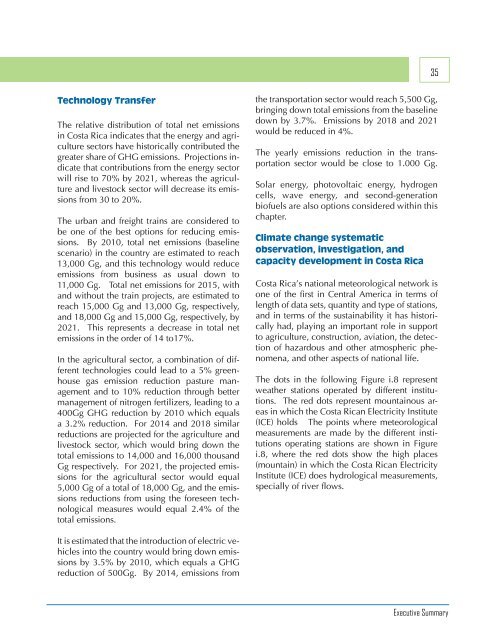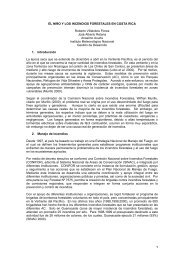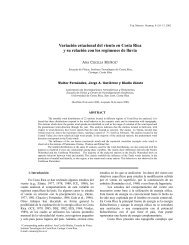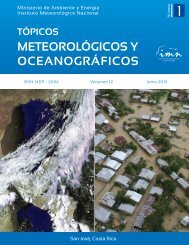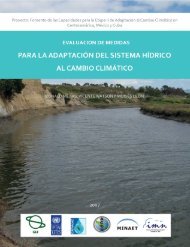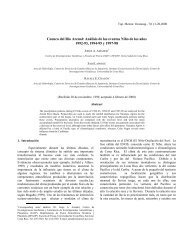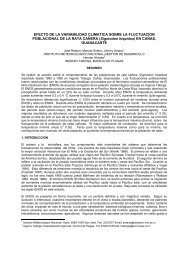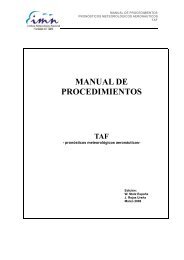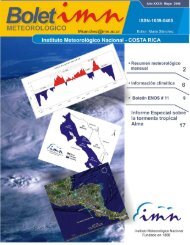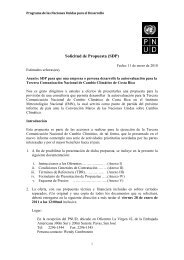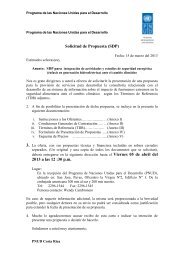descargar Documento - IMN - Instituto Meteorológico Nacional
descargar Documento - IMN - Instituto Meteorológico Nacional
descargar Documento - IMN - Instituto Meteorológico Nacional
You also want an ePaper? Increase the reach of your titles
YUMPU automatically turns print PDFs into web optimized ePapers that Google loves.
35<br />
Technology Transfer<br />
The relative distribution of total net emissions<br />
in Costa Rica indicates that the energy and agriculture<br />
sectors have historically contributed the<br />
greater share of GHG emissions. Projections indicate<br />
that contributions from the energy sector<br />
will rise to 70% by 2021, whereas the agriculture<br />
and livestock sector will decrease its emissions<br />
from 30 to 20%.<br />
The urban and freight trains are considered to<br />
be one of the best options for reducing emissions.<br />
By 2010, total net emissions (baseline<br />
scenario) in the country are estimated to reach<br />
13,000 Gg, and this technology would reduce<br />
emissions from business as usual down to<br />
11,000 Gg. Total net emissions for 2015, with<br />
and without the train projects, are estimated to<br />
reach 15,000 Gg and 13,000 Gg, respectively,<br />
and 18,000 Gg and 15,000 Gg, respectively, by<br />
2021. This represents a decrease in total net<br />
emissions in the order of 14 to17%.<br />
In the agricultural sector, a combination of different<br />
technologies could lead to a 5% greenhouse<br />
gas emission reduction pasture management<br />
and to 10% reduction through better<br />
management of nitrogen fertilizers, leading to a<br />
400Gg GHG reduction by 2010 which equals<br />
a 3.2% reduction. For 2014 and 2018 similar<br />
reductions are projected for the agriculture and<br />
livestock sector, which would bring down the<br />
total emissions to 14,000 and 16,000 thousand<br />
Gg respectively. For 2021, the projected emissions<br />
for the agricultural sector would equal<br />
5,000 Gg of a total of 18,000 Gg, and the emissions<br />
reductions from using the foreseen technological<br />
measures would equal 2.4% of the<br />
total emissions.<br />
the transportation sector would reach 5,500 Gg,<br />
bringing down total emissions from the baseline<br />
down by 3.7%. Emissions by 2018 and 2021<br />
would be reduced in 4%.<br />
The yearly emissions reduction in the transportation<br />
sector would be close to 1.000 Gg.<br />
Solar energy, photovoltaic energy, hydrogen<br />
cells, wave energy, and second-generation<br />
biofuels are also options considered within this<br />
chapter.<br />
Climate change systematic<br />
observation, investigation, and<br />
capacity development in Costa Rica<br />
Costa Rica’s national meteorological network is<br />
one of the first in Central America in terms of<br />
length of data sets, quantity and type of stations,<br />
and in terms of the sustainability it has historically<br />
had, playing an important role in support<br />
to agriculture, construction, aviation, the detection<br />
of hazardous and other atmospheric phenomena,<br />
and other aspects of national life.<br />
The dots in the following Figure i.8 represent<br />
weather stations operated by different institutions.<br />
The red dots represent mountainous areas<br />
in which the Costa Rican Electricity Institute<br />
(ICE) holds The points where meteorological<br />
measurements are made by the different institutions<br />
operating stations are shown in Figure<br />
i.8, where the red dots show the high places<br />
(mountain) in which the Costa Rican Electricity<br />
Institute (ICE) does hydrological measurements,<br />
specially of river flows.<br />
It is estimated that the introduction of electric vehicles<br />
into the country would bring down emissions<br />
by 3.5% by 2010, which equals a GHG<br />
reduction of 500Gg. By 2014, emissions from<br />
Executive Summary


